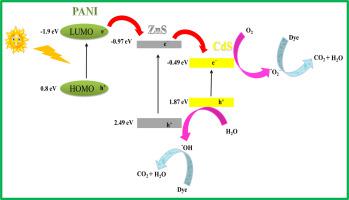Colloid and Interface Science Communications ( IF 4.7 ) Pub Date : 2020-11-01 , DOI: 10.1016/j.colcom.2020.100330 Heba Ali , Eman S. Mansor

|
Toxic pollutants such as organic dyes are released from different industries and discharged into water sources leading to a serious health problem. Herein, mesoporous ZnS with large surface area (207.4 m2/g) synthesized by a new and simple surfactant free method at room temperature. Next, ZnS modified with CdS to get a series of ZnS/CdS binary hybrids (ZC1, ZC2, ZC3 and ZC4). After that, various amounts of polyaniline (PANI) were added to produce a series of ZnS/CdS/PANI ternary composites (ZC2P1, ZC2P2, ZC2P3, and ZC2P4) for the first time. The sensitization with PANI led to an increase in surface area and pore diameter. The degradation percentage of ZnS, ZC2, and ZC2P3 is 54.7%, 81.1%, and 96.5%, respectively. The degradation rate constant of 20 mg/L RhB in presence ZnS, ZC2 and ZC2P3 is 0.5 × 10−2, 0.91 × 10−2, and 1.7 × 10−2 min−1, respectively. A possible mechanism for the enhanced photocatalytic activity is proposed.
中文翻译:

介孔ZnS与CdS和聚苯胺的共敏化可有效地光催化降解阴离子和阳离子染料
有毒污染物(例如有机染料)从不同的行业释放出来并排放到水源中,导致严重的健康问题。在此,通过新型且简单的无表面活性剂的方法在室温下合成了大表面积(207.4 m 2 / g)的介孔ZnS 。接下来,用CdS修饰的ZnS得到一系列ZnS / CdS二元杂化物(ZC1,ZC2,ZC3和ZC4)。之后,首次添加各种量的聚苯胺(PANI),以生产一系列ZnS / CdS / PANI三元复合物(ZC2P1,ZC2P2,ZC2P3和ZC2P4)。用PANI致敏导致表面积和孔径增加。ZnS,ZC2和ZC2P3的降解百分比分别为54.7%,81.1%和96.5%。在ZnS,ZC2和ZC2P3存在下20 mg / L RhB的降解速率常数为0.5×10-2,0.91×10 -2和1.7×10 -2 分钟-1,分别。提出了增强光催化活性的可能机理。











































 京公网安备 11010802027423号
京公网安备 11010802027423号